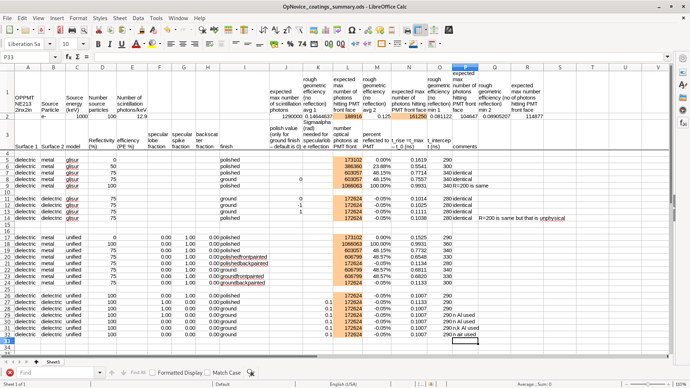I’m running a Geant4 10.5 patch 01 simulation to test the effect of different coatings on scintillators. For the initial tests, I am using a general particle source (GPS) isotropically emitting 1 MeV electrons at the center of a 2.54 cm x 2.54 cm cylindrical NE213 scintillator. I am counting the number of optical photons that intersect one of the flat faces of the scintillator (where the PMT would be coupled). My code is a modified version of OpNovice from the Geant4 examples, which I have modified to allow particle-dependent scintillation yields and which counts scintillation and optical photons and records their properties at the PMT face.
The simple geometry consists of the scintillator, completely surrounded by a cylindrical aluminum container with 2 mm thick walls, except for the one flat side where optical photons are counted. That side is made of glass. I am varying optical properties of the aluminum can to study the impact on the number of optical photons detected by the PMT.
When I use a dielectric/metal interface with either Glisur or Unified model, things behave roughly as expected. If I set the container reflectivity to 0%, I get a minimum number of photons detected (173102), which roughly agrees with the number expected from geometry considerations (175083; the average of two simple geometry approximations 161250,188916). As reflectivity increases to 100%, the number of photons detected increases proportionally, as expected. Ground or polished finishes give the same result, and unified/backpainted apparently has 0% reflection.
However, the dielectric/dielectric interface with either Glisur or Unified model yields slightly less than 0% reflected photons no matter what parameters I choose. I have tried all the combinations that I used for dielectric/metal plus I have tried varying the fractions of specular lobe to specular spike to backscatter. I have tried including the refractive index of the container. I used both a real refractive index (real part of that for Al and also that for air) and out of desperation a complex refractive index for aluminum (although I recognize that only real index is supposed to be used for dielectric/dielectric.)
I have read all the G4 documentation including the Boundary Process Section in Physics Processes Book for Application Developers and all related papers that I can find. I have even gone through the G4OpBoundaryProcess.cc and .hh source code.
But the dielectric/dielectric interface just does not reflect any optical photons. Am I missing something obvious?
I have attached a screenshot of a spreadsheet of some results. Calculated and expected photon numbers are highlighted in orange for each run.
